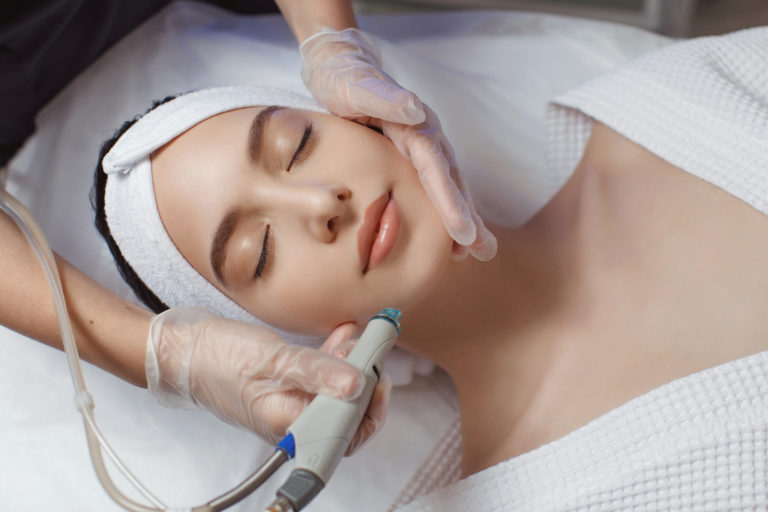What Is a Hydrafacial and How Does It Work?

May 13, 2024
What is a Hydrafacial and how does it work? HydraFacials are a special skin treatment you can get at medical spas or dermatology offices. It’s sometimes called “hydradermabrasion” because it combines exfoliation like microdermabrasion with hydrating serums. The HydraFacial involves three steps: deep cleaning, exfoliation, and hydrating your skin. This professional treatment can address various skin issues such as acne, wrinkles, and dryness.
It’s a gentle procedure that’s not invasive, similar to a regular facial at a spa. However, it’s said to give more noticeable results. A special wand is used to cleanse and exfoliate your skin while delivering serums designed for your skin type.
If you’re interested, keep reading to learn more about the potential benefits, any possible side effects, and how HydraFacial compares to other treatments.
Call to schedule at 727-404-0857

HydraFacial Benefits
HydraFacials are known to enhance skin tone, texture, and overall appearance. The thorough pore cleansing helps clear away debris, paving the way for serums customized for your skin to penetrate better.
HydraFacial for Acne
There aren’t any clinical studies showing the benefits of HydraFacial for treating acne. Microdermabrasion is often used for acne and scars because it removes pore-clogging cells through exfoliation.
HydraFacial Blackheads
Blackheads are also caused by dead skin cells. The same extraction and exfoliating methods used in HydraFacial treatment may help this type of non-inflammatory acne. However, more studies are needed to confirm the benefits.
HydraFacial Rosacea
There are a few cosmetic treatments safe for sensitive skin. A 2006 study found that similar techniques could help with papulopustular skin conditions.
HydraFacial for Anti-aging Concerns
In a small 2008 study of 20 women, HydraFacial treatments resulted in a better decrease in signs of skin aging than serums used alone. This included smaller pores and less hyperpigmentation.

HydraFacial Side Effects and Precautions
The HydraFacial is generally considered safe, with few complications. During the procedure, you might feel some light pressure but it shouldn’t be painful or irritating. However, it’s best to avoid getting a HydraFacial if you have an active rash or flare-up.
Is Hydrafacial Safe During Pregnancy?
Before getting any cosmetic procedures like the HydraFacial while pregnant, it’s important to consult your doctor first. A review from 2017 found that while these treatments are usually safe, there haven’t been studies to confirm this.
Can a Hydrafacial Lead to a Breakout of Acne?
The HydraFacial treatment targets excess oil and dead skin to prevent breakouts. It clears impurities through deep exfoliation. Let your provider know about any allergies or sensitive skin before treatment, as this could cause breakouts afterward. If you experience breakouts following a HydraFacial, follow up with your provider.
How Does HydraFacial Treatment Work?
HydraFacials are done by licensed aestheticians or dermatologists and have three stages:
- First, a vortex-like tool is used to clear dirt and oil deep within your pores. Then, a peel exfoliates your skin and restores its surface.
- Next, a wand with a vacuum attachment removes debris from the pores.
- Finally, a serum is applied using a pen-like device.
Sometimes, after a HydraFacial, you might choose to have additional skin care treatments like Dermal Fillers or Light Therapy. These are extras and not part of the HydraFacial itself.
Hydrafacial Aftercare
No downtime is required for each HydraFacial treatment. You can go back to your regular activities right away, unlike with more intense procedures like chemical peels. Even though you shouldn’t notice any peeling or redness after the HydraFacial, it’s still best to avoid exfoliating treatments in the first few days afterward.
How Frequently Should You Have a Hydrafacial Done?
Your provider will determine how often you should get HydraFacial treatments based on your skin type. Some websites suggest having the treatment once every four weeks, while others recommend every two weeks. A dermatologist or aesthetician can help you decide how many sessions are right for your skin and goals.
Costs of HydraFacial
HydraFacials cost more than regular facials, typically around $175 per session on average. This price may increase if you opt for booster treatments or other extras. Costs can vary based on where you are.
If you’re used to getting monthly facials with microdermabrasion, chemical peels, and exfoliation, you might find that the 3-in-1 HydraFacial is slightly less expensive.
Like regular spa treatments, HydraFacials are cosmetic procedures that are not covered by insurance. You can ask your provider about cost-saving options, like membership packages that offer monthly discounts.

Hydrafacial vs. Microdermabrasion
Microdermabrasion, like a HydraFacial, exfoliates your skin. It uses small crystals and is great for acne scars, fine lines, wrinkles, and age spots. Unlike a HydraFacial, it doesn’t involve serums.
Dermalinfusion vs. HydraFacial
Dermalinfusion is much like HydraFacial in both tech and perks. Both give a triple treatment: cleaning, scrubbing, and applying special serums to fix your skin issues. However, Dermalinfusion might lead to redness and irritation, unlike HydraFacial.
Hydrafacial and Radiofrequency Therapy
Radiofrequency Therapy uses heat to help make more collagen and renew skin cells deep under the skin. This can make the skin tighter and smoother. It might also help treat acne. While both HydraFacial therapy and Radiofrequency treatment help with skin aging, Radiofrequency doesn’t use exfoliation or serums. After each session, Radiofrequency may make the skin red.
Takeaway
A HydraFacial can target various skin issues in just one session. Its 3-in-1 process of cleansing, exfoliating, and hydrating may offer assistance. Consulting a dermatologist for advice on suitable cosmetic treatments tailored to your concerns is recommended. Contact us today!
Transform your skin with our Hydrafacial services and reveal a radiant glow. Book your appointment today and experience the ultimate rejuvenation at Enduring Beauty in St. Petersburg, FL. Rediscover your beauty with us. Your skin deserves it.